A key design goal for Windows SharePoint Services 3.0
was to have it more tightly integrated with Microsoft Office
applications. Although Windows SharePoint Services 3.0 supports earlier
versions of Office, the most complete integration will—no surprise—come
with Office 2007 products. However, many organizations tend to have a
mixture of different versions of Office. Some clients still have Office
2000 products, 2003 products, and are just starting (at the time of this
writing) to implement Office 2007 products, so it is important to test
the performance of the installed versions with Windows SharePoint
Services 3.0.
Using Word 2007 with Windows SharePoint Services 3.0
When Word 2007 is used to open a
document from a SharePoint 2007 document library, the user can access
metadata and other information stored in Windows SharePoint Services
3.0. To view the Document Properties Ribbon, as shown in Figure 1,
click the Office Button, then select Prepare, and Properties. To show
the Document Management pane, which is visible on the right side of Figure 1, click the Office Button, then select Server, and Document Management Information.
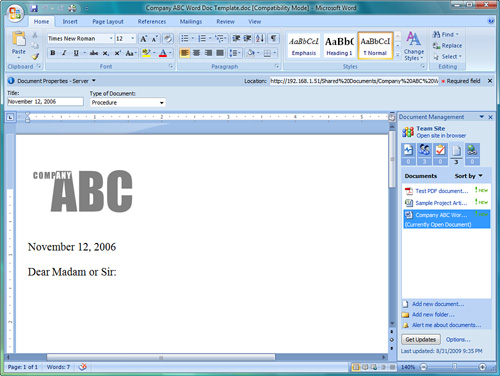
As shown in Figure 35.21,
the Type of Document metadata column created previously for this
document library is visible under the Document Properties – Server
title. In the Document Management pane on the right, five options are
available, each of which provides data from SharePoint:
Status option— Lists important status information about the current document.
Members option—
Lists which individuals and groups have access to the document library,
and which users are online or not online. An email can be sent to all
members from this tab.
Tasks option—
Shows tasks from the primary Tasks list on the Windows SharePoint
Services 3.0 site that houses the document library. New tasks can be
added, alerts can be set, and workflow tasks can be viewed.
Documents option—
Shows the other documents in the home library for the open document.
New documents and new folders can be added, and alerts can be created.
Links option— Displays any links that are present in a Links list on the home site. A new link can be added, or an alert can be created.
The Publish link from under
the Office button can also be used. Two standard options offered are to
publish to a blog or to a document management server. If the Blog option
is selected, the user is shown a preview and is asked to select the
SharePoint blog site to publish to. If the Document Management Server
option is chosen, the Save As window opens with a list of possible
locations.
Another entry option in the
Office button in Word 2007 is the Server entry. It provides some
additional tools, which are available when a document has been opened
from SharePoint 2007. One of these is Check Out, if the document is not
already checked out. Another is View Version History, which allows the
user to see the version number, modified date, user who made the
changes, size of the document, and any comments. And if any workflows
are available in the document library that houses the document, a View
Workflow Tasks option will be available.
This ease of use for
accessing information encourages users to share, collaborate, and
communicate together on projects, initiatives, or ideas without having
to leave the comfort of the Word 2007 application.
Using Excel 2007 with Windows SharePoint Services 3.0
Excel 2007 offers the same level
of connectivity as Word 2007 in terms of the Document Properties Ribbon
and Document Management pane. Excel 2007 also has some additional ways
of linking to Windows SharePoint Services 3.0 lists, quite possibly
because Excel data is so similar to data stored in SharePoint lists, or
because Microsoft understands the importance of encouraging users to
adopt SharePoint technologies as an alternative to Excel spreadsheets,
and to enhance collaboration.
One way of sharing data in an
Excel workbook with SharePoint 2007 users is to export the contents to a
SharePoint list. For this to work, you first need to create a table in
Excel 2007, populate it, and then initiate the export process. An
extremely powerful feature of SharePoint lists is that multiple people
can edit them at the same time, which can be an advantage over users
fighting to check out, edit, and check in documents one at a time. So
the following exercise is helpful as a way of demonstrating the
collaboration capabilities of a list that houses Excel data.
To export an Excel 2007 table to a Windows SharePoint Services 3.0 list, follow these steps:
1. | On
a worksheet with data, select the range of cells that you want to make
into a table. From the Insert tab, in the Tables group, click Table.
|
2. | The Create Table window opens. Define the range, and check the My Table Has Headers check box, if needed.
|
3. | Click OK. A table is created that includes the data in the defined range, as shown in Figure 2.
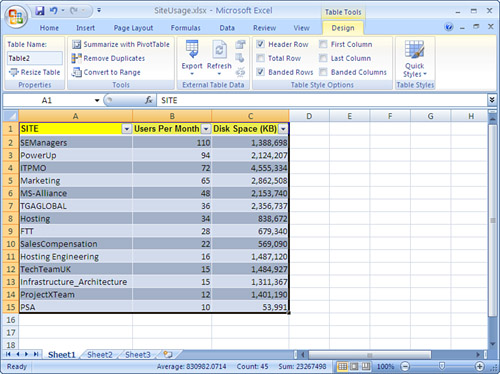
|
4. | If
necessary, select a cell in the table, so that the Design tab becomes
active, access the Export drop-down menu, and select Export Table to
SharePoint List. The Step 1 of 2 window opens, as shown in Figure 3. Enter the address of the site to be published to and the name of the table. Click Next.
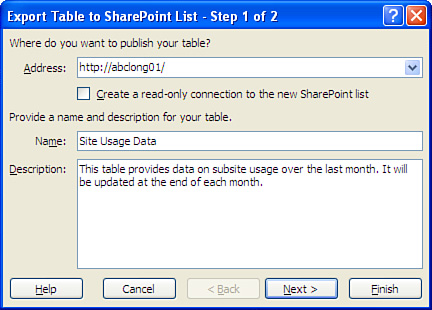
|
5. | The
Step 2 of 2 window opens, and it summarizes the data types that will be
used (for example, Text(single line) or Number or Date). Formulas are
stripped at this point, and only the values are kept. Click Finish.
|
6. | A
summary window opens stating “The table was successfully published” and
provides a URL to the new list. Click this URL to open the new list.
|
7. | Figure 4
shows the new list, in this case titled Site Usage Data. Note that
because the data was exported, there is no longer a link between Excel
and this data.
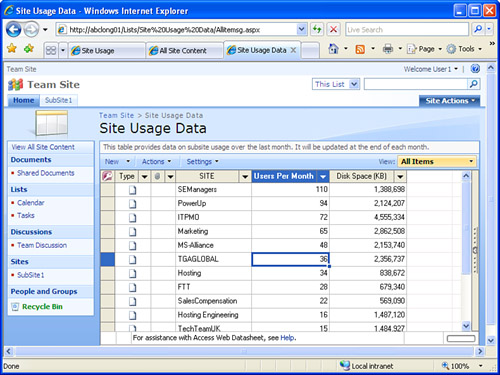
|
Caution
Using the Export Table to
SharePoint List option is a great way to quickly publish data to a
Windows SharePoint Services 3.0 table. However, this is a one-time
export, so if the spreadsheet is updated later, you cannot re-export it
to the same SharePoint list!
Exporting to Access 2007 from a SharePoint 2007 List
A Windows SharePoint Services
3.0 list also provides the ability to export list data to an Access
2007 list so that the administrator can leverage some of the powerful
analysis tools of Access 2007. The administrator can create forms, pivot
charts, reports, or queries.
Simply click on Export to
Access from the Office Links, which can be accessed on the right side of
the screen in Datasheet view of a list, as shown in Figure 5.
After the data is opened in Access 2007, you can easily create a report
with a few mouse clicks, as shown in Print Preview mode in Figure 6.
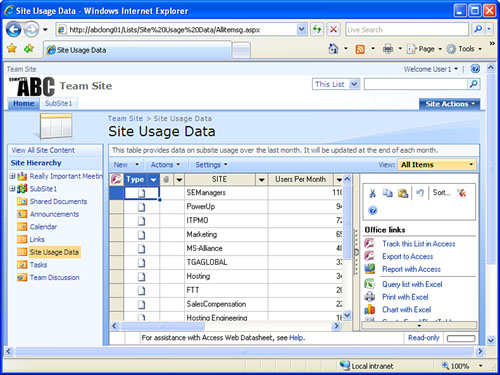
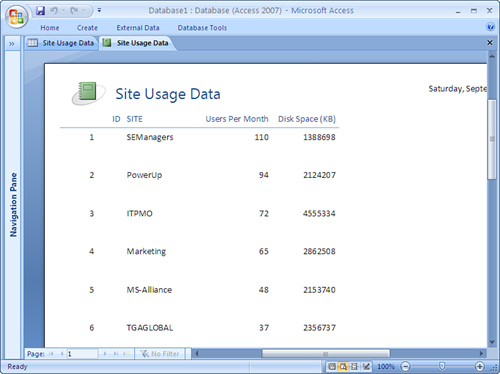
Many
other tools are available in Access 2007, which makes it well suited
for repurposing data from Windows SharePoint Services 3.0. For example,
data can be exported to
Excel 2007
SharePoint 2007 or Windows SharePoint Services 3.0 list
Rich Text Format File (ideal for then using in Word 2007)
Text file
Other formats, including XML file, ODBC database, HTML document, or merged with Word
Many users saw little if any use
for Access with SharePoint data in the past, but Microsoft has worked
hard to improve the effectiveness of the tools provided in Access 2007,
which now makes it an ideal companion to Windows SharePoint Services
3.0.